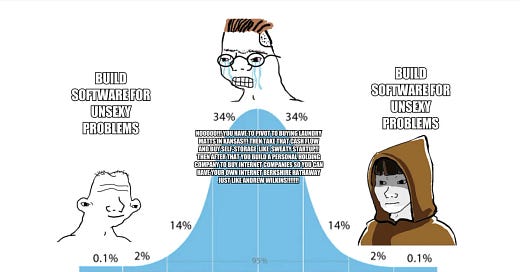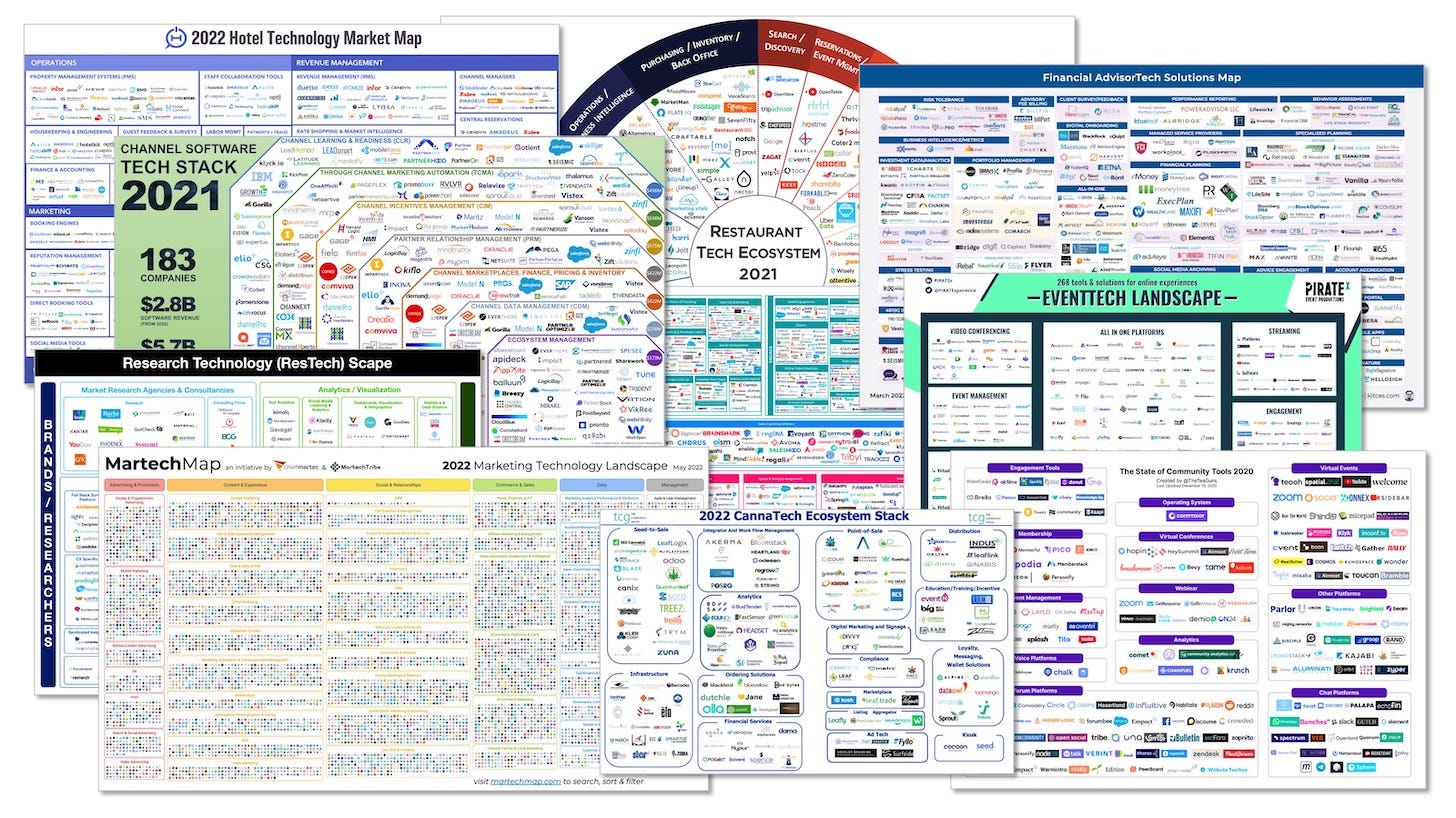Software is still eating the world. But chasing sexy opportunities or low-hanging fruit is a losing proposition for most of us.
Rather than pursuing high-status, cool ideas, more founders should start companies that solve unsexy problems and compete in unsexy industries.
Software’s Proliferation
It’s been almost 12 years since Marc Andreesen’s essay “Why Software is Eating the World” was published.
In the decade+ since, we’ve seen that Andreesen was by and large right. Software companies and products have proliferated.
AWS drove the cost to build software exponentially lower. Zoom made it easier to connect with anyone, anywhere, about anything.
Smartphones and the app store drove a massive wave of new consumer internet companies — Uber, Snapchat, Spotify, Airbnb, etc.
E-commerce became ubiquitous. Today, there’s a massive ecosystem of digitally native brands and software companies that support them. (For a visual illustration see the market maps below.)
In B2B, the cloud arrived and has largely been adopted across the enterprise, triggering a proliferation of SaaS apps for every conceivable problem and workflow. (Below is a 2022 market map of the B2B software industry.)
Software has become cheaper and easier to create. Add product-led growth, freemium, GTM playbooks, and an era of abundant capital – and you get a recipe for creating a hyper-competitive market.
And SaaS has never been more competitive than it is today.
A Founder’s Dilemma
The sheer proliferation of competition makes starting a new software company and building new products daunting for prospective founders.
In a sea of competition, what makes you think that you have something new to contribute? Even if you do, how can you possibly stand out in all the noise?
While the arrival of LLMs as a new platform has sparked life, it hasn’t alleviated the existential concerns many founders feel. All the low-hanging fruit opportunities in AI are quickly being seized by incumbents who already have distribution and hundreds of opportunistic startup founders. Just look at the most recent YC batch.
Large language models bring new anxieties for builders. Many fear a world in which software becomes easier and faster to replicate than ever before, driving the returns of software companies lower.
Several of my friends have contemplated pivoting out of tech entirely. Starting CPG companies, getting into real estate, or buying a small business.
I take the other side of this argument. While I understand the angst (and god knows I’ve felt it too), I believe there are still tremendous opportunities in software. But I also believe that the opportunity to build easy shit is largely over.
The Startup Opportunity Spectrum
My framework is that if you’re starting a tech company today you want to be at one of two extremes:
Building unsexy software
Building frontier tech
On one end of the spectrum, you have software’s march into unsexy problems and industries. Examples would include vertical SaaS, logistics, financial services, healthcare, etc.
On the other, you have the frontier of technology. Think areas like AI, quantum computing, biotech, etc. (Side note – Building an LLM wrapper is not building at the frontier of AI.)
While this analogy is imperfect, it’s the heuristic I’ve been operating from.
Where to hunt
Most founders starting companies today would be better off choosing the unsexy side of this spectrum.
Personally, I’m not willing to bet my career on beating Open AI, Google, Anthropic, etc. in LLMs. Nor am I willing to bet on being the 1 startup in 100 that finds a way to build an enduring company in “gen AI copywriting” or “gen AI outbound marketing for SDRs” faster than the incumbents or the dozens of venture-backed startups pursuing this.
Most of you probably shouldn’t either.
I am willing to bet that I can find a boring, unsexy problem, in a great market, build a better product, and distribute the shit out of it. Playing my role as a good soldier in the fight to spread the gospel of our Lord and Savior Shareholder Value.
In all seriousness — Go spend time in an old industry like logistics, where Excel dominates workflows. Go follow your average SMB owner around for a day. Go spend time in the finance and accounting stack at most enterprises. Go see how much manual data entry your average government employee still does.
Be more observant of the problems your peers and colleagues complain about. You’d be shocked by how many “solved problems” are not in fact that solved. You’d be shocked how many SaaS winners have let their products stagnate and their support decline. How many of the disruptors are ripe to become the disrupted.
Modern technology is not as distributed as you’d think. Opportunities still abound for those that look closely.
A personal anecdote
A few years ago I had a Shopify side hustle with a friend. We did a few thousand dollars a month selling subscription boxes of home fragrances. One of the biggest pain points we encountered was subscription billing. To do this within Shopify, we used a multi-billion dollar company called Recharge. Recharge lets you charge subscriptions at checkout on your Shopify store.
Recharge is one of the more painful products I’ve ever used. We had so many issues with getting the product set up, maintaining it, interacting with their customer support, etc.
You know what I did about it? Nothing. A year later multiple startups had launched to challenge Recharge on Shopify alone.
Could I have been one of those startups? Probably. Why wasn’t I? Because I figured if they were already worth billions there was no way I could compete with them.
Competition doesn’t = solved problems
Competition validates a market. It means people care about the problem enough to pay for a solution.
The proliferation of software does not equate to a similar proliferation of solved problems and satisfied customers.
My friend Sophia Deng had a great articulation of this in her piece Mo’ software, same problems.
Here’s a cynical take, one I think should be honestly put forth – most recent B2B software hasn’t been substantially better for users. Smart founders have been flooding the startup ecosystem for the last 5 years like hypebois to Supreme. But instead of searching for t-shirts, teams have been rabidly searching for any problem to solve and any opportunity to capture customer value. The result has been a flood of software vying to be part of the worker’s day-to-day: Pick ME to be where you perform your core activities or Pick ME to be where you input in key data. But it’s unclear whether these products - made in a pressure cooker of hyper-speed and hyper-competition - have been designed with any real secret or differentiated insight into how to benefit users.
To Sophia’s point, startup founders and VCs have flooded the market, but it’s to be determined how much lasting value will come from all the noise and dollars.
Beneath it all lies opportunity. Opportunity to cut through the noise. To fix unsolved problems. To make something people want. To build new companies and new products. To substantiate new points of view.
Software is still eating the world. It just already ate the easy shit.
The low-hanging fruit presented by the dawn of the internet, mobile, the cloud, and e-commerce has been eaten.
You’re not going to be the first productivity tool.
You’re not going to be the first person to put X in the cloud.
You’re not going to build the first dating app.
You’ll probably have competitors. You’ll probably face incumbents.
As builders, we can cry about this. We can bemoan our luck, timing, etc. But fundamentally we don’t control how much competition exists today or how little low-hanging fruit remains.
We do control — The opportunities we choose. The depth and thoughtfulness by which we approach products and GTM. The ambition that we apply to company building.
If you dig deeper, you’ll find that consumers and companies still have problems. You’ll find incumbents aren’t always getting the job done. You’ll find large categories with shockingly few modern products. You’ll find hard and unsexy schleps that no one wants to tackle.
There’s a lot of money to be made building and distributing software in unsexy, boring, and hard places.
Thanks to Erik de Stefanis, Evan McCracken, Eli Dukes, and David Zhou for their feedback on this post.
Side Notes
If you’re not pursuing a venture-backed path, being a tiny player in a sexy category might be good enough for you. (though I would still argue that there are lots of great unsexy niches worth pursuing)
This piece was written from the point of view of building something enduring with the potential to achieve considerable scale. That said, there’s a counterargument to this that my friend Anu articulates here.
A question that underlies this piece is whether you’re pursuing status or financial success when starting a company. Pursuing an unsexy business will give you very little status while building it. Whereas, sexy businesses pay handsomely in status. For many founders, the status compensation far outweighs the financial. This is a topic that I’d like to write about more in the future.
The side note that’s true for most of my internet writing – Take everything with a grain of salt. I’m wrong often, and very well might change my mind. Think for yourself.












Great read, particularly love this:
"In a sea of competition, what makes you think that you have something new to contribute? Even if you do, how can you possibly stand out in all the noise?"